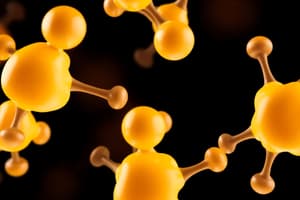Podcast
Questions and Answers
Match the following fatty acid types with their characteristics:
Match the following fatty acid types with their characteristics:
Saturated fats = Contain no C=C groups Unsaturated fats = Feature one or more C=C groups Long-chain triglycerides = Contain 16, 18, or 20 carbon atoms Medium-chain triglycerides = Contain shorter fatty acids
Match the following fatty acid synthesis abilities with their possessors:
Match the following fatty acid synthesis abilities with their possessors:
Animals = Synthesize even-numbered fatty acids Bacteria = Possess the ability to synthesize odd- and branched-chain fatty acids Ruminant animals = Contain odd-numbered fatty acids, such as 15, due to the action of bacteria in the rumen Humans = Synthesize even-numbered fatty acids
Match the following triglyceride constituents with their sources:
Match the following triglyceride constituents with their sources:
Body fat in humans and other vertebrates = Main source of triglycerides Vegetable fat = Source of triglycerides Blood = Enables the bidirectional transference of adipose fat and blood glucose from the liver Human skin oils = Major component of triglycerides
Match the following fatty acid chain lengths with their triglyceride classifications:
Match the following fatty acid chain lengths with their triglyceride classifications:
Match the following fatty acids with their characteristics:
Match the following fatty acids with their characteristics:
Match the following oils with their characteristics:
Match the following oils with their characteristics:
Match the following fatty acid residues with their positions on the glycerol hub:
Match the following fatty acid residues with their positions on the glycerol hub:
Match the following processes with their effects on fatty acids:
Match the following processes with their effects on fatty acids:
Match the following terms related to triglycerides with their definitions:
Match the following terms related to triglycerides with their definitions:
Match the following statements about triglycerides with their correct descriptions:
Match the following statements about triglycerides with their correct descriptions:
Match the following terms used in the nomenclature of triglycerides with their meanings:
Match the following terms used in the nomenclature of triglycerides with their meanings:
Match the following characteristics of triglycerides with their corresponding explanations:
Match the following characteristics of triglycerides with their corresponding explanations:
Match the following terms related to triglycerides with their properties:
Match the following terms related to triglycerides with their properties:
Match the following statements about triglycerides with their correct explanations:
Match the following statements about triglycerides with their correct explanations:
Flashcards are hidden until you start studying
Study Notes
Triglycerides: Structure, Biosynthesis, and Nomenclature
- Triglycerides are esters derived from glycerol and three fatty acids, formed through a condensation reaction.
- Natural fats contain a mixture of individual triglycerides, melting over a broad range of temperatures, except for cocoa butter, which is composed of only a few triglycerides.
- Triglycerides can exist in different crystalline forms (polymorphs) such as α, β, and β′, each differing in their melting points.
- The biosynthesis of triglycerides involves the selective condensation of specific fatty acids with the hydroxyl functional groups of glycerol, leading to non-random fats like lard and cocoa butter.
- Triglycerides are named after their source or traditional names, and their chemical fatty acid names are commonly used as esters of those acids.
- In IUPAC nomenclature, fatty acids are named based on the position and orientation of carbon-carbon double bonds, with oleic acid being formally named as (9Z)-octadec-9-enoic acid.
- Triglycerides take formal IUPAC names according to the rule governing naming of esters and can also be denoted using a specific fatty acid code.
- Saturated fats contain predominantly saturated fatty acids without double bonds, while unsaturated fats have predominantly unsaturated acids with double bonds.
Studying That Suits You
Use AI to generate personalized quizzes and flashcards to suit your learning preferences.



